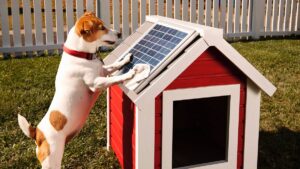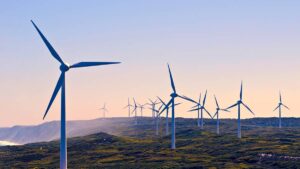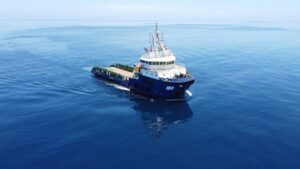Emission Control: These ‘Dirty Dozen’ companies are responsible for 40% of Australia’s greenhouse gas emissions

Pic: Getty Images
- New Climate Council report outlines top 12 fossil fuel companies doing more than most to fuel climate crisis
- Credit Suisse downgrades FMG over doubts on FFI green hydrogen projects
- Neighbourhood batteries, the latest technology rolled out in a $10 million Queensland first initiative
A group of 12 Australian fossil fuel companies have been dubbed ‘the Dirty Dozen’ in a damning Climate Council report, stating they have collectively emitted 287 million tonnes of CO2 since 2016.
Chevron Australia, Woodside Energy, Anglo American, Santos, BHP, Glencore Coal, Inpex, Shell Australia, ConocoPhillips, South32, Esso Australia and Centennial Coal have made it on the list and together, produce about 40% of all greenhouse gas emissions (GHG) regulated by Australia’s Safeguard Mechanism.
The Safeguard Mechanism is a set of rules that regulates Australia’s 215 biggest polluters that emit more than 100,000 tonnes of emissions per year.
For the first time, the government is proposing to set big polluters in the Safeguard Mechanism annual targets for emissions reduction (‘baselines’) and impose financial penalties if they don’t meet these.
These new rules, which come into effect from July this year, aims to incentivise corporations to transform how they operate so that they cut their emissions and avoid penalties.
No carbon offsets and no new coal or gas projects
But experts say the government’s new framework is still not harsh enough to drive Australia’s absolute emissions down and claim the safeguard mechanism’s use of carbon credits and offsets should be used sparingly.
The Climate Council is calling on the Government to strengthen the Safeguard Mechanism and warns Australia won’t be able to meet – or ideally from a science perspective, beat – legislated emissions reduction targets and make real progress if the 12 companies in this report do not pull their weight.
“To do that we should ensure the Dirty Dozen can’t buy carbon offsets to keep on polluting as usual, nor can we allow any new coal or gas projects,” Dr Jennifer Rayner, Hhead of Advocacy at Climate Council says.
“If we get the Safeguard Mechanism reform right, it can deliver the biggest cuts to industrial emissions ever seen in Australia.
“These big polluters have had a free ride and it is time for them to pull their weight in our shared national effort to cut emissions.”
Rayner says there are currently over 100 new coal, oil, and gas projects in the proposal pipeline in Australia and if even a fraction of those go ahead without tighter regulation, it is going to put a safe climate even further out of reach.
“The Safeguard Mechanism should treat new entrants much more strictly by ensuring they can’t just ride off their extra emissions with offsets and ensuring they don’t have access to any of the public subsidies or public support that are being providing in the Safeguard Mechanism package,” she explains.
“We want to see those subsidies go to steel, cement, and aluminium – those strategically important industries Australia needs to keep here on shore and not to new fossil fuel projects.”
Credit Suisse and Macquarie cast doubts over FFI hydrogen projects
Last week global investment bank, Credit Suisse, downgraded the performance of Fortescue Metals Group (ASX:FMG) from ‘neutral’ to ‘underperform’ stating while operationally FMG remains hard to fault, the exit of Plug Power reinforces doubts towards project economics under FMG’s green arm, Fortescue Future Industries (FFI).
The news came after US-based hydrogen company Plug Power announced its decision to withdraw from the joint venture and its involvement with the electrolyser manufacturing facility in Gladstone, Queensland.
Credit Suisse research analysts Saul Kavonic and Alex Ren said FFI has made has plans to advance five green energy projects to final investment decisions this calendar year, despite there being “little visibility on economics, offtakes and funding.”
“FFI theoretically has upside potential especially if spun off… but with FMG up 50 per cent since November, we think much is already priced in and see opportunity to take profit and switch to peers with better valuation metrics,” they said.
Macquarie analysts voiced a similar sentiment, saying an update on FFI activities presents a key catalyst.
“We note PlugPower has over 48 years of experience in proton exchange membrane (PEM) electrolysers, and this setback presents uncertainties to the timeline for the 2GW electrolyser development, in our view,” the report said.
FMG has confirmed it will continue the project with in-house knowledge and is studying both PEM and alkaline technologies.
Infinite Green Energy eyes 2024 production
Infinite Green Energy (IGE) completed the acquisition of Perth’s Northam Solar Farm and signed its first offtake contract last week, putting it good stead to produce four tonnes a day of renewable hydrogen via electrolysis at the 11MW project in the last quarter of 2024.
The hydrogen output will initially power Fuel Cell Electric Vehicle (FCEV) truck fleets for several key back to base customers.
Infinite Green Energy, chaired by former Woodside CEO Peter Coleman, will begin a $3 million capital raising to fund production capacity of the Northam project (MEG HP1) and the pathway towards planned production of the company’s flagship, 23 tonne/day Arrowsmith project.
Coleman said the strategic acquisition of the Northam Solar Farm and capital raising would allow IGE to progress the Northam project to final investment decision.
IGE plans to expand the Northam Solar Farm capacity to 18MW and connect a 10MW electrolyser for green hydrogen production in the second half of 2024.
QLD launches neighbourhood batteries
Neighbourhood batteries are the latest technology being rolled out in a $10 million Queensland first initiative between publicly owned Energex and retailer Origin (ASX:ORG).
The two companies will deliver 35 neighbourhood batteries across Ipswich as part of the Palaszczuk Government’s Queensland Energy and Jobs Plan.
The batteries, which will be made of up to 30 power pole-mounted and five ground-level, will complement the large-scale network-connected batteries being rolled out across the Ergon Energy network in regional Queensland.
They will store cheap excess energy generated by the equivalent of nearly 600 rooftop solar systems during the day.
Energy, Renewables and Hydrogen Minister Mick de Brenni said the neighbourhood batteries offered numerous benefits to communities including increased energy reliability, reduced energy costs, and a cleaner energy supply.
“Queensland has all the ingredients needed to lead the renewable energy revolution – we’re already doing it with our record amounts of rooftop solar,” Minister de Brenni said.
Queensland continues to be the nation’s leader in rooftop solar with homes accounting for more than 3.5GW capacity from solar – more generation capacity than the State’s two largest power stations in Gladstone and Stanwell combined.
Here’s how renewable energy companies are tracking:
| CODE | COMPANY | PRICE | 1 WEEK RETURN % | 1 MONTH RETURN % | 6 MONTH RETURN % | 1 YEAR RETURN % | MARKET CAP |
|---|---|---|---|---|---|---|---|
| AVL | Aust Vanadium Ltd | 0.036 | 16% | 38% | -12% | -3% | $157,090,508 |
| BSX | Blackstone Ltd | 0.17 | 0% | 31% | -29% | -71% | $80,475,474 |
| DEL | Delorean Corporation | 0.062 | -11% | -15% | -50% | -72% | $13,374,697 |
| ECT | Env Clean Tech Ltd. | 0.011 | 0% | 0% | -48% | -61% | $18,878,768 |
| FMG | Fortescue Metals Grp | 21.95 | -2% | 8% | 22% | 4% | $68,476,179,776 |
| PV1 | Provaris Energy Ltd | 0.0685 | 20% | 59% | 14% | -32% | $37,557,212 |
| GNX | Genex Power Ltd | 0.15 | 7% | 11% | -32% | -14% | $207,776,571 |
| HXG | Hexagon Energy | 0.018 | 13% | 6% | 20% | -68% | $9,232,486 |
| HZR | Hazer Group Limited | 0.605 | 0% | 6% | -10% | -36% | $103,118,465 |
| IFT | Infratil Limited | 8.17 | 0% | 1% | 0% | 12% | $5,914,945,865 |
| IRD | Iron Road Ltd | 0.105 | -5% | -25% | -30% | -45% | $84,254,757 |
| LIO | Lion Energy Limited | 0.034 | -11% | 13% | -6% | -32% | $14,487,748 |
| MEZ | Meridian Energy | 4.86 | 0% | -1% | 3% | 11% | $6,140,680,164 |
| MPR | Mpower Group Limited | 0.022 | 10% | 22% | -8% | -45% | $6,461,472 |
| NEW | NEW Energy Solar | 0.066 | 4% | 4% | 50% | 52% | $21,158,807 |
| PGY | Pilot Energy Ltd | 0.019 | -5% | 12% | 12% | -59% | $14,845,538 |
| PH2 | Pure Hydrogen Corp | 0.185 | -5% | 0% | -33% | -57% | $65,703,454 |
| PRL | Province Resources | 0.059 | -2% | 0% | -49% | -55% | $69,708,095 |
| PRM | Prominence Energy | 0.0015 | -25% | -25% | -40% | -88% | $3,636,913 |
| QEM | QEM Limited | 0.21 | 11% | 14% | 17% | 17% | $28,380,149 |
| RFX | Redflow Limited | 0.2 | -9% | -7% | -58% | -56% | $35,943,872 |
| SKI | Spark Infrastructure | 0 | -100% | -100% | -100% | -100% | $5,036,718,784 |
| VUL | Vulcan Energy | 7.2 | -2% | 15% | -4% | -20% | $1,034,168,520 |
| CXL | Calix Limited | 5.66 | 4% | 29% | -16% | 9% | $1,015,266,575 |
| KPO | Kalina Power Limited | 0.014 | 0% | -7% | -30% | -42% | $21,212,741 |
| RNE | Renu Energy Ltd | 0.06 | -5% | 25% | 9% | -22% | $26,430,127 |
| NRZ | Neurizer Ltd | 0.085 | -8% | -12% | -43% | -43% | $94,561,190 |
| LIT | Lithium Australia | 0.047 | 0% | 2% | -33% | -59% | $57,396,009 |
| TVN | Tivan Limited | 0.084 | 1% | 12% | -13% | 14% | $116,627,131 |
| SRJ | SRJ Technologies | 0.125 | -4% | 25% | -71% | -71% | $11,146,907 |
| NMT | Neometals Ltd | 0.82 | -6% | 3% | -31% | -40% | $472,593,705 |
| MR1 | Montem Resources | 0.04 | 0% | 0% | 0% | -7% | $12,913,190 |
| FGR | First Graphene Ltd | 0.099 | 0% | -6% | -27% | -45% | $57,550,322 |
| EGR | Ecograf Limited | 0.245 | 17% | 9% | -18% | -61% | $110,331,697 |
| EDE | Eden Inv Ltd | 0.005 | 0% | 0% | -44% | -72% | $14,657,135 |
| CWY | Cleanaway Waste Ltd | 2.76 | -1% | 7% | 3% | -3% | $6,188,280,334 |
| CPV | Clearvue Technologie | 0.21 | -5% | 18% | -31% | -39% | $45,582,884 |
| CNQ | Clean Teq Water | 0.39 | -3% | 5% | -38% | -37% | $22,507,016 |
| M8S | M8 Sustainable | 0.009 | -25% | 29% | 29% | -50% | $4,418,176 |
| EOL | Energy One Limited | 4.4 | -2% | -2% | -17% | -34% | $131,722,888 |
| FHE | Frontier Energy Ltd | 0.465 | 6% | 9% | 55% | 258% | $116,627,220 |
| LPE | Locality Planning | 0.049 | -2% | -9% | -23% | -61% | $8,729,658 |
| GHY | Gold Hydrogen | 52 | -1186% | $26,520,000 |
Who’s got news out?
PROVARIS ENERGY (ASX:PV1)
The Western Australian Government released the Compressed Hydrogen Export Feasibility Study Public Sharing Report, first announced in September 2021.
Provaris says the study received funding from the Renewable Hydrogen Fund as part of the Western Australian Government’s Renewable Hydrogen Strategy.
It indicates that a compressed hydrogen export supply chain is technically and commercially feasible for the offshore loading and export of green hydrogen, with an average delivery rate of over 98% of the target annual throughput.
The study analysed the compression and export of 200,000 tonnes per annum of green hydrogen from the proposed HyEnergy hydrogen production facility in WA’s Gascoyne region and includes compression facilities, an outgoing pipeline to an offshore loading terminal, a fleet of Provaris’ proprietary H2Neo 26,000 m3 GH2 Carriers, and an import terminal in Singapore.
Related Topics
UNLOCK INSIGHTS
Discover the untold stories of emerging ASX stocks.
Daily news and expert analysis, it's free to subscribe.
By proceeding, you confirm you understand that we handle personal information in accordance with our Privacy Policy.








